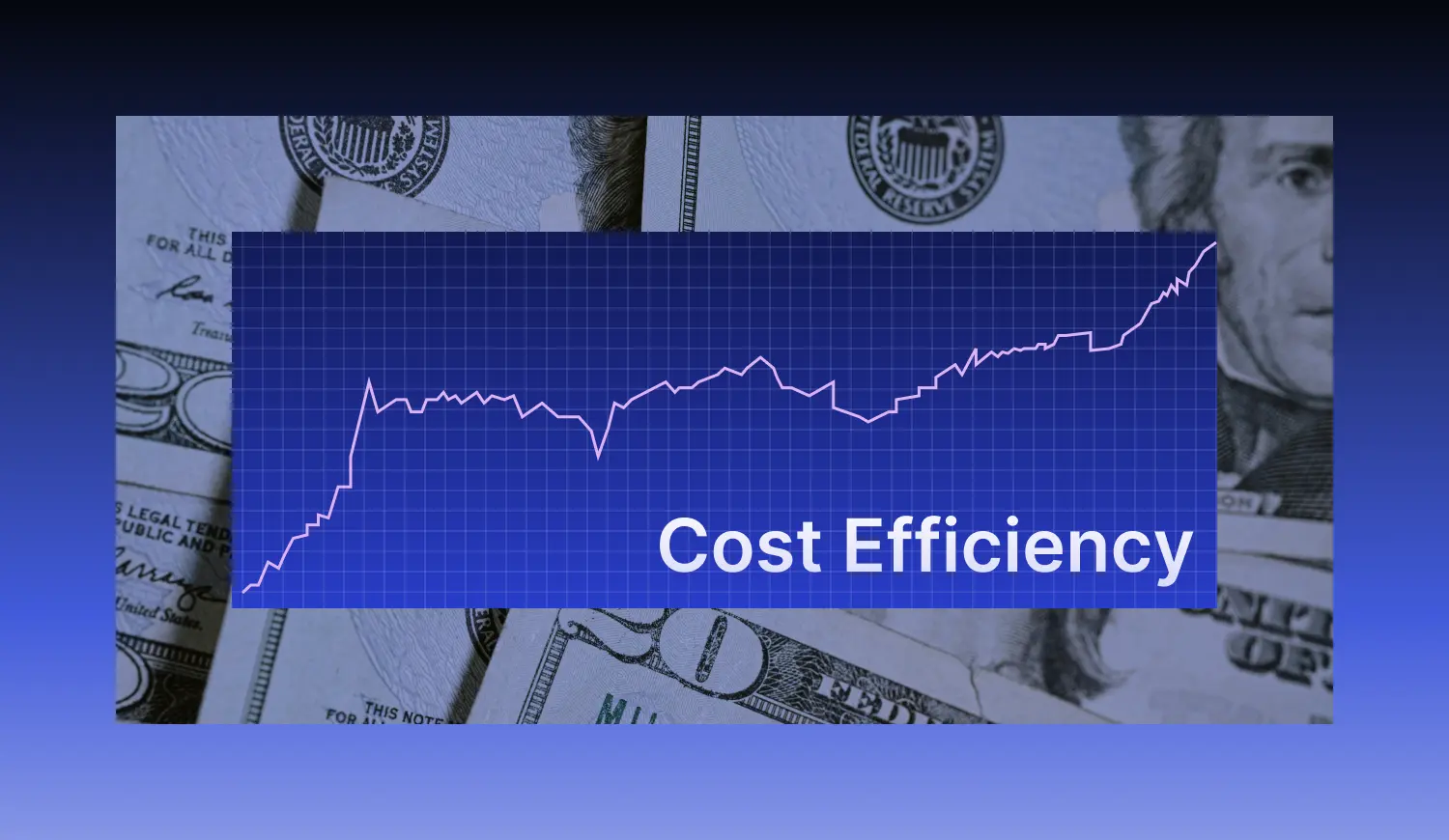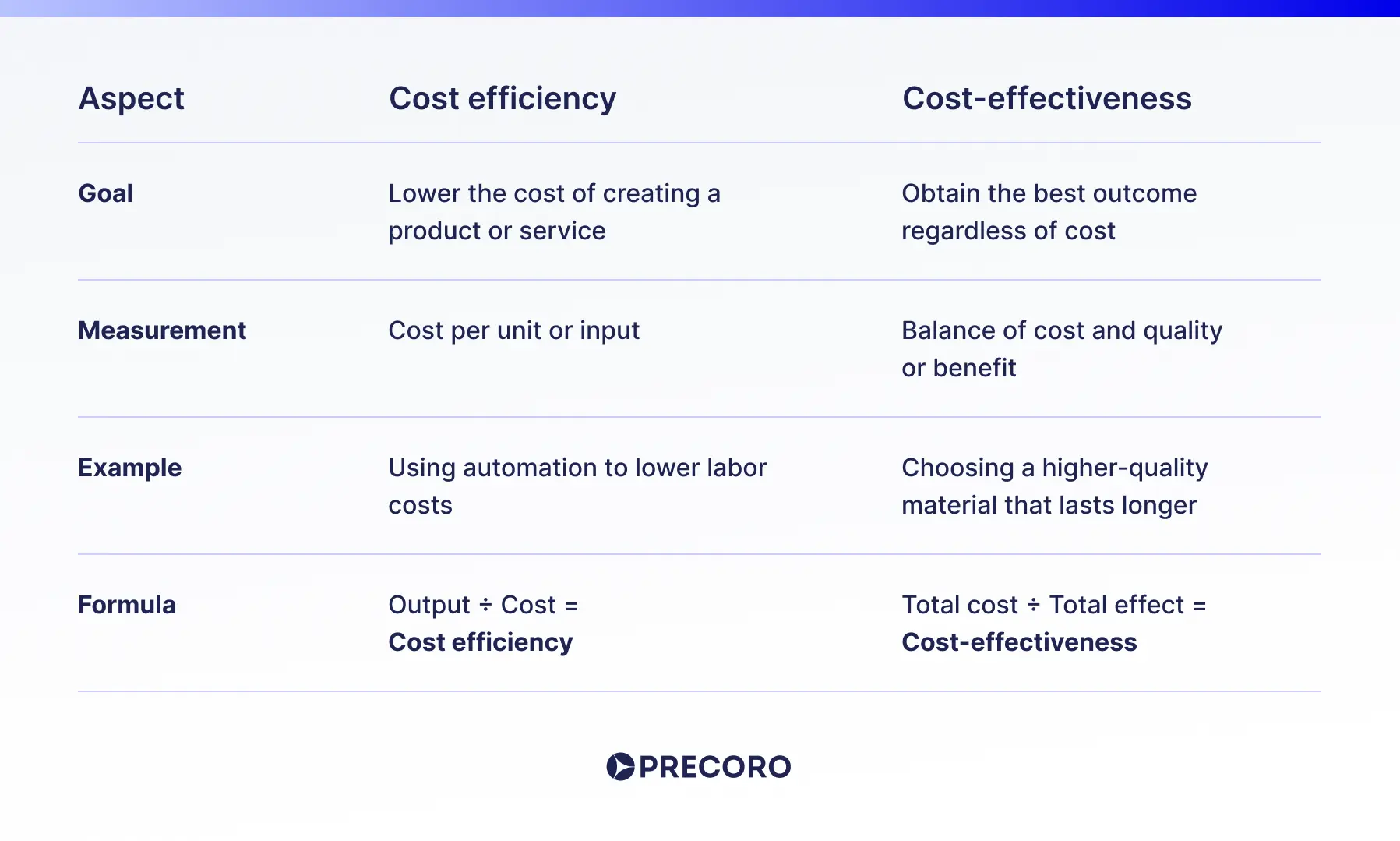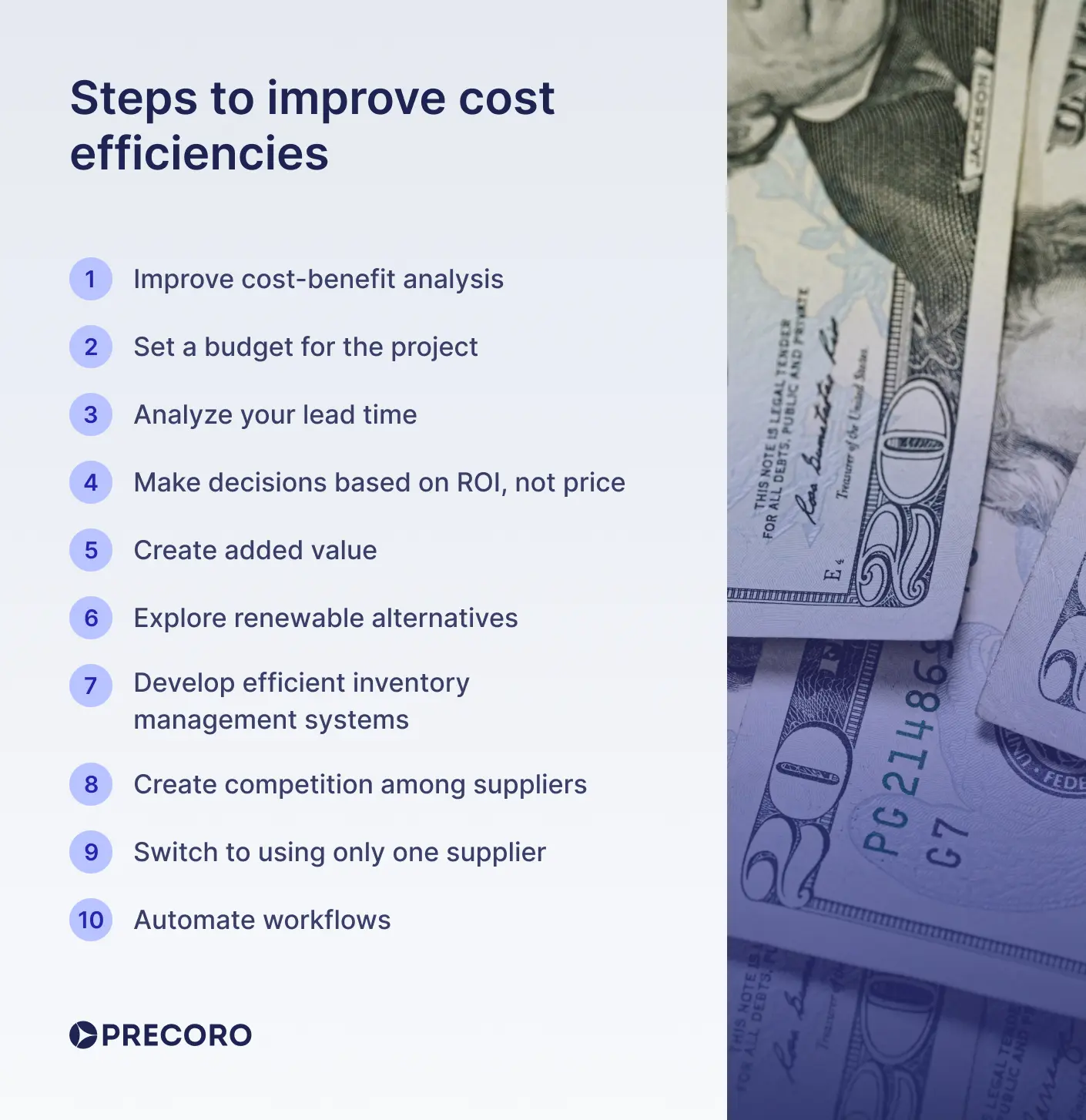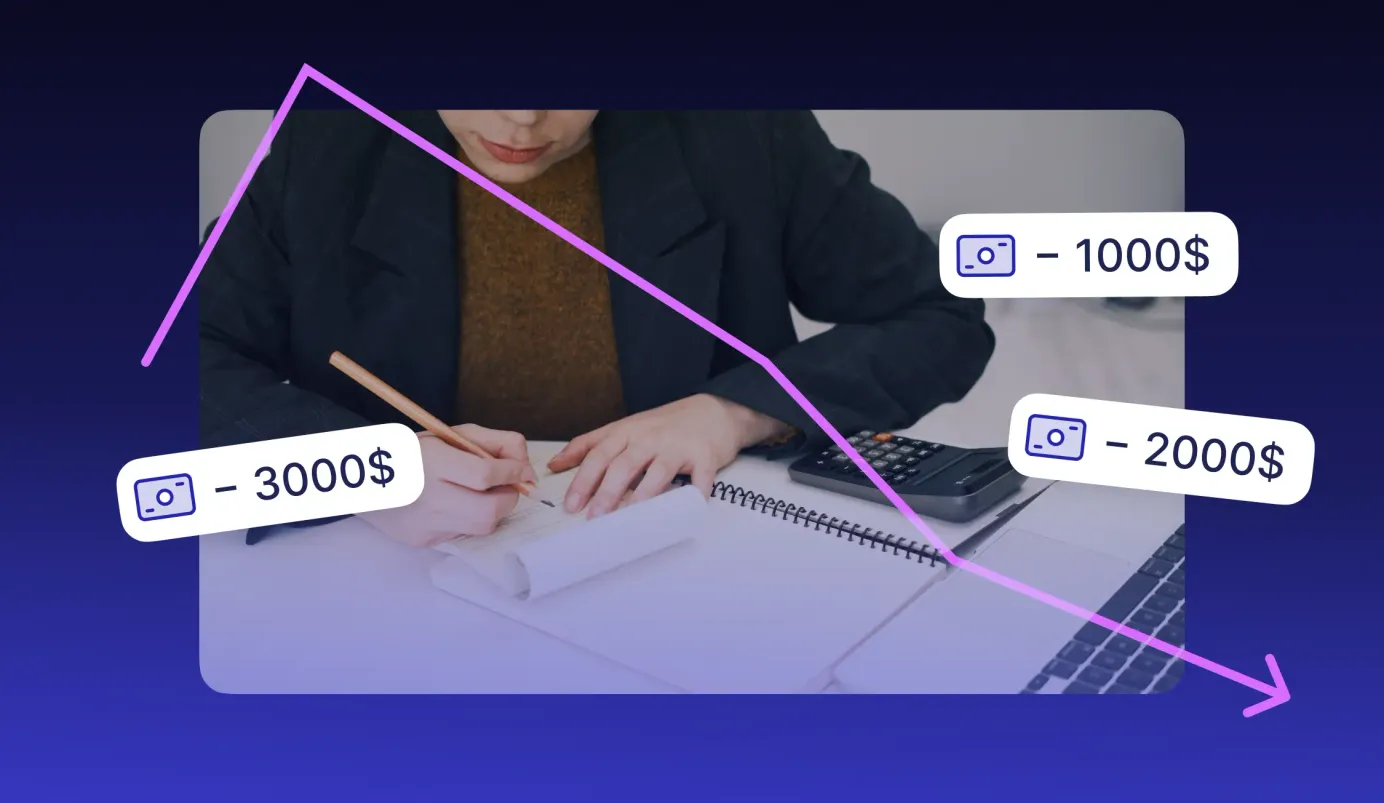
13 min read
Cost Efficiency: Definition, Examples, and Best Practices
A complete guide to cost efficiency in operations, budgeting, and procurement. Learn definitions, examples, and top methods to cut waste and maximize ROI.
Every dollar counts, especially when expenses spike and profits shrink. In times like these, cost efficiency becomes the real hero. Think of it as optimizing every process, from your operations to marketing campaigns, to ensure you get the best investment return. The path to sustained growth begins with smart spending.
In this guide, we’ll explore what cost efficiency is, examples, and best practices on how cost efficiency can make your company more competitive and profitable in today's fast-paced economy.
Keep reading to learn:
Cost-efficient vs. cost-effective: What's the difference?
Cost-efficient meaning
Formula for cost efficiency
Cost-effective definition
Formula for cost-effectiveness
Cost efficiency online calculator
Benefits of cost efficiency for your company
Steps to improve cost efficiencies
Frequently asked questions about cost efficiency
Cost-efficient vs. cost-effective: What's the difference?
You’ve probably heard the terms cost-effective and cost-efficient thrown around in meetings or business strategy sessions, but do you actually know the difference? You might be tempted to treat them as interchangeable, but doing so can lead to flawed decision-making.
Though they sound alike, the two have distinct meanings. According to Dictionary.com:
Effective (adj.)—Adequate to accomplish a purpose; producing the intended or expected result.
Efficient (adj.)—Performing best with the least wasted time and effort.

Cost-efficient meaning
Cost efficiency is the act of saving money or spending less money by changing a product or process to work in a better way. The more efficiently a company can operate, the cheaper its products and services will be compared to those in the same industry. Put simply, what cost efficiency is can be defined as how well you use your resources to achieve your goals.
Think of cost efficiency in this way: instead of keeping a bunch of expensive servers in the back room that constantly require maintenance, a company moves everything to the cloud. Suddenly, there’s no more hardware to babysit; IT headaches drop, and the whole setup runs cheaper and scales more easily. Another good example is switching to e-procurement software—basically ditching the piles of paperwork and endless approvals. It speeds things up, cuts administrative costs, and makes the whole process smoother, much like upgrading from charcoal to a gas grill.
Formula for cost efficiency
Cost efficiency measures how well resources are used to produce outputs. It is often expressed as the ratio of outputs (or outcomes) to costs incurred:
cost efficiency = output or outcomes ÷ cost incurred- This formula shows how many units or measurable results you get per unit of cost.
- Output of outcomes can be units produced, services delivered, or any measurable result.
- Costs include the total expenditure for producing those outputs.
Remember that the specific formula can vary depending on your context or industry.
Example of cost efficiency
A TechRepair Company operates two service plans: Plan A costs $6,000 monthly and services 1,200 devices. Plan B costs $5,500 monthly and services the same number of devices. Which strategy is cost-efficient?
Calculations
Cost efficiency of plan A = 1,200 Devices ÷ 6,000 dollars = 0.2
Cost efficiency of plan B = 1,200 Devices ÷ 5,500 dollars = 0.2182
In this case, you have observed that plan A services 0.2 devices per dollar, whereas plan B services 0.2182 devices per dollar. Hence, plan B is comparatively more cost-efficient.
Cost-effective definition
Cost-effective is often used as a synonym for low cost. However, in business, cost-effectiveness meaning refers to maximizing profits while minimizing expenses. It means a transaction or action provides the most significant benefit for a comparatively low price. In essence, something is considered cost-effective when it delivers value for the amount of money spent.
Formula for cost-effectiveness
Cost-effectiveness measures the cost required to achieve a specific outcome. It is expressed as the ratio of costs incurred to outcomes achieved:
cost-effectiveness = total cost ÷ total effect- This formula shows the cost per unit of outcome.
- Costs include all expenses related to the process or intervention.
- Total effect refers to measurable benefits such as cases prevented, lives saved, or services delivered.
Example of cost-effectiveness
Let’s take an example of CleanEnergy, a renewable energy company. It offers two solar panel installation programs aimed at reducing household energy costs. In program A, 300 homes are fitted with solar panels for $150,000. Meanwhile, in program B, 400 homes are fitted with solar panels at $200,000. What are cost-effectiveness calculations?
Calculations
Cost-effectiveness ratio for program A = 150,000 dollars ÷ 300 homes = 500
Cost-effectiveness ratio for program B = 200,000 dollars ÷ 400 homes = 500
As you noticed, both program A and program B are equally cost-effective. At this point, decision-makers need to consider more factors such as long-term energy savings, environmental impact, and scalability when choosing a solar installation program.
Types of cost efficiency metrics
Here are five main types of cost efficiency metrics:
- Cost per unit: Total cost divided by units produced (e.g., cost per product or service).
- Return on Investment (ROI): (Gain from investment - Cost of investment) / Cost of investment, expressed as a percentage.
- Labor cost per output: Total labor costs divided by units produced or services delivered.
- Cost-benefit ratio: Total costs divided by total benefits (monetary or quantified).
- Cost Performance Index (CPI): Earned value divided by actual costs, used in project management (CPI < 1 indicates overbudget).
Cost efficiency online calculator
Since we’ve uncovered the cost-efficient meaning, now plug in your numbers to find hidden savings and pinpoint areas to boost margins. The cost efficiency calculator shows you where to cut waste and where to invest for maximum growth.
Cost efficiency calculator
Benefits of cost efficiency for your company
Better cost efficiency means more profits and improved resilience. Here’s a quick look at the advantages.
Increased profit margins
When you focus on cost efficiency, you cut costs while preserving output quality and quantity, which results in higher profits. It also opens up time that can be redirected toward growing production or uncovering new revenue sources.
Environmental benefits
Many believe sustainable practices are costly, but according to the cost-efficient meaning, the most cost-efficient solutions are often the most sustainable. Near-sourcing cuts carbon emissions, and waste-minimizing material strategies increase asset value. Installing smart energy monitors can lower electricity bills.
Competitive advantage
A cost-efficient business uses fewer resources, which increases flexibility and resilience. It can cut prices to challenge competitors, remain resilient in economic downturns, or launch swiftly with fewer investor demands.
How to achieve cost efficiency
Cost efficiency starts with smarter spending, leaner operations, and no loss in quality. This supports sustainable growth and profit stability. Let’s walk through the steps to achieve it:
Perform a cost-benefit analysis
Every financial decision has the potential to either propel or hinder a business’s growth, competitive strength, and profitability. A cost-benefit analysis enables you to evaluate the advantages and disadvantages of various decisions. These analyses are typically carried out for one of two reasons:
- A business decision is examined to check if the benefits outweigh the costs, and by how much, to determine whether it should proceed.
- Two or more options are evaluated to determine which provides the best benefit-to-cost ratio.
A basic cost analysis breaks down into a few clear steps. For each business decision:
- List all related costs.
- List all expected benefits.
- Ensure both lists are thorough and specific.
Key cost categories include:
- Direct costs: Raw materials, labor, and inventory.
- Indirect costs: Rent, utilities, overhead.
- Opportunity costs: Time that blocks other pursuits, such as internal production versus outsourcing.
- Intangible costs: Damage to brand, effects on employee well-being.
- Risk-related costs: Environmental impact, compliance demands, competitive threats.
Invest in Procure-to-Pay (P2P) software
Today’s global economy is driven by Big Data, and without the right tools to collect and analyze it, companies risk losing their competitive edge. A dedicated procure-to-pay solution like Precoro shows a clear picture of where corporate money is going and offers more control over how it's spent.
These tools help you source from lower-cost countries, run procurement more efficiently, keep your supply chain moving, and avoid inventory pileups. That's how you can reduce costs and stay competitive, even as the market keeps shifting. Additionally, supply chain software increases efficiency, and multi-echelon inventory optimization helps balance inventory levels.

Promote an efficiency-first mindset
Make cost efficiency a cultural standard. Without employee alignment around cost-efficient practices, better outcomes remain out of reach.
Ensure each department knows how to apply cost and time efficiency in practice. Consider using the cost responsiveness frontier chart to map where you stand.
Centralize business operations
For higher cost efficiency, consolidate business activities. Departments that operate independently waste resources. Consolidation brings efficiency through greater scale and stronger negotiation power.
Drive innovation and value growth
The ultimate goal of any business is to provide value for the consumer. Prioritize innovation and value creation to boost cost efficiency. As the company delivers more value to consumers, it will discover methods to lower costs and support growth.
Practice proactive pricing
A low-cost procurement strategy can improve cost efficiency. A company that offers lower prices or reduced quality can win price-sensitive customers and gain market share. In contrast, a premium brand can raise prices without raising costs. Using brand strength or market trends, the business increases margins without investing more in quality. Both approaches improve cost efficiency, but each requires a firm grasp of customer priorities and the market landscape.
Steps to improve cost efficiencies
Competition is ruthless. Whether you’re scaling a startup or driving an established business forward, cutting costs without cutting corners is the game-changer.
Smart companies don’t just slash expenses—they optimize spending and ensure every dollar fuels growth. To provide the lowest price possible while not compromising quality, here are a few ways to improve cost efficiency:
Improve cost-benefit analysis
Cost-benefit analysis helps you evaluate the economic value of a project. It’s a powerful tool for achieving cost efficiency, as it helps you determine whether the project’s benefits outweigh the costs. Plus, this analysis gives you a clear framework to compare projects and choose the most cost-efficient option.
Set a budget for the project
A solid project budget helps you manage costs and allocate resources effectively. The people and firms you hire are key assets and your biggest expenses. Knowing your project’s direction and calculating costs accurately is essential. With a realistic budget, you can identify cost-saving opportunities without sacrificing the quality of the project’s outcome.
Analyze your lead time
You can't cut costs without knowing where they stem from. To identify this, track how your team uses its time. Understand lead times for tasks and the effort level required to complete them. Then, analyze how time was spent to make future estimates more accurate.
Make decisions based on ROI, not price
Most business owners understand the concept of cost efficiency: reduce costs, increase profit. However, many overlook that the key factor is not just price but return on investment (ROI). Cutting costs isn't enough; you must ensure those cuts provide value in the long run. Too often, companies save money upfront but lose out on value and money down the road. This is especially true with IT services. Choosing a cheaper option may seem like a good idea, but it can lead to hidden costs that outweigh the initial savings.
Create added value
Look for fresh opportunities to add value to your current products and services. Think about new features, integrations, or better customer support. These improvements can attract new customers and increase profits.
Explore renewable alternatives
Switch to renewable resources or more eco-friendly alternatives to reduce your environmental impact. Focus on optimizing energy use and investing in durable products. Energy-efficient appliances, smart thermostats, timed lights, and treated windows are great choices.

Develop efficient inventory management systems
Set up an inventory management system to track your stock in real time. This tool will ensure you order the correct quantities and avoid overstock or obsolete items. An automated procurement system can also notify you once items hit a low stock threshold so you can reorder in time.
Create competition among suppliers
Request bids from new ones to uncover better prices. Inform your current supplier about your plans to switch. This pressure may push them to offer a better deal. Keep alternatives ready in case they refuse to match.
Switch to using only one supplier
Switching to a single supplier may lower procurement costs and simplify operations. One vendor may offer bulk discounts, while fewer transactions can reduce paperwork. However, always keep a list of alternatives in case the main supplier fails to deliver.
Automate workflows
Explore ways to reduce manual labor and allow employees to dedicate their time only to the most important tasks. Look for opportunities to automate workflows and integrate processes with one another.
Frequently asked questions about cost efficiency
Cost efficiency is the ratio of input costs to the returns generated. It underscores the importance of minimizing expenses while maintaining the quality of products or services to ensure optimal fund use.
To determine if something is cost-effective or cost-efficient, note that cost efficiency refers to cheaper products or services. The cost-effectiveness meaning, on the other hand, mostly focuses on high quality at a lower price. Cost-effectiveness often takes priority in business. Investing in quality may cost more upfront, but it leads to higher long-term profitability. For example, if a company spends more money on the best quality and gets better results—it will be more profitable in the long run.
An example of cost efficiency is switching from printed materials to digital documents to reduce printing and paper costs. Other examples include outsourcing non-core tasks to lower labor expenses or renegotiating supplier contracts to decrease material costs.
Procurement controls spending on goods and services, negotiates prices, and ensures quality, directly impacting overall cost efficiency.
Companies often struggle to improve cost efficiency due to limited visibility into true costs and spending. Resistance to change and outdated processes can slow down or block cost-saving initiatives. Fragmented departments and poor communication lead to inefficiencies and duplicated efforts. Additionally, focusing on short-term savings rather than long-term improvements can undermine sustainable efficiency gains.
How Precoro can help with cost efficiency
Precoro helps with cost efficiency primarily by centralizing and automating procurement processes. The platform reduces manual tasks, prevents errors, and provides full visibility and control over company spending. Here are the key ways you can achieve cost efficiency with Precoro:
- Centralized procurement & spend visibility
Control all purchasing in one platform with real-time spend tracking and budget oversight. Stop rogue and unapproved spending before it impacts your bottom line. - Automation & time savings
Automate requests, approvals, and invoices. Precoro cuts manual work by 80% and saves 5+ hours per employee weekly. - Budget control & approvals
Set clear budget limits and approval rules by amount or category. Precoro helps you ensure policy compliance and contract adherence. - Supplier & contract management
Centralize catalogs and contracts, consolidate buying, and secure bulk discounts. You can save 5% on every dollar spent. - Real-time reporting & analytics
Access full procurement data in Precoro’s dashboards and reports, surface inefficiencies, and drive smarter cost decisions. - Scalability & flexibility
Adjust the platform to any team or company size. Change roles, workflows, or modules without disrupting operations.









